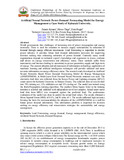Artificial Neural Network Power Demand Forecasting Model for Energy Management a Case Study of Kabarak University.
Abstract
World governments face challenges of increasing rate of power consumption and energy
insecurity. There is need for countries to increase supply sustainability by reduction of
demand through energy efficient investments. Load forecasting is important in electric
power industry. It provides future load demand information necessary for improving
decision making thus enhancing reduction of power demand. Currently many world
organizations depend on technical expert’s knowledge and experience to assess, evaluate
and advice on energy conservation and efficiency status. These methods suffer from
inaccuracies and biasness leading to uncertainty in power generation, supply and high costs
of energy. The current adoption and advancement of information technology, application of
machines learning and artificial intelligence techniques will provide unbiased and more
accurate information on energy efficiency status. The research study developed an Artificial
Neural Networks Based Power Demand Forecasting Model for Energy Management
(ANNPDFMEM). A Multi-Layer Feed Forward Neural Networks structure was used. The
electricity load data was collected from the Kenya Power and Lighting company (KPLC)
smart meters for Kabarak University in Nakuru County. The collected data set was divided
into 70% training set, 15% validation set and 15% testing set. The model was trained using
the Back-Propagation learning algorithm. The smallest Mean Square Error in the training
iteration is selected and validated with independent set of test samples. Actual smart meter
load data from KPLC was compared against the predicted load. The performance
evaluation of the model was done to predict the actual load values. The results obtained a
Mean Squared Error (MSE) of 9.5%, and R value of 1. The results indicated high accuracy
forming the basis for recommendation for adoption of the (ANNPDFMEM) as a tool for
future power demand information. This information platform is important for decision
making on energy efficiency and conservation strategies for sustainability and energy
management.

